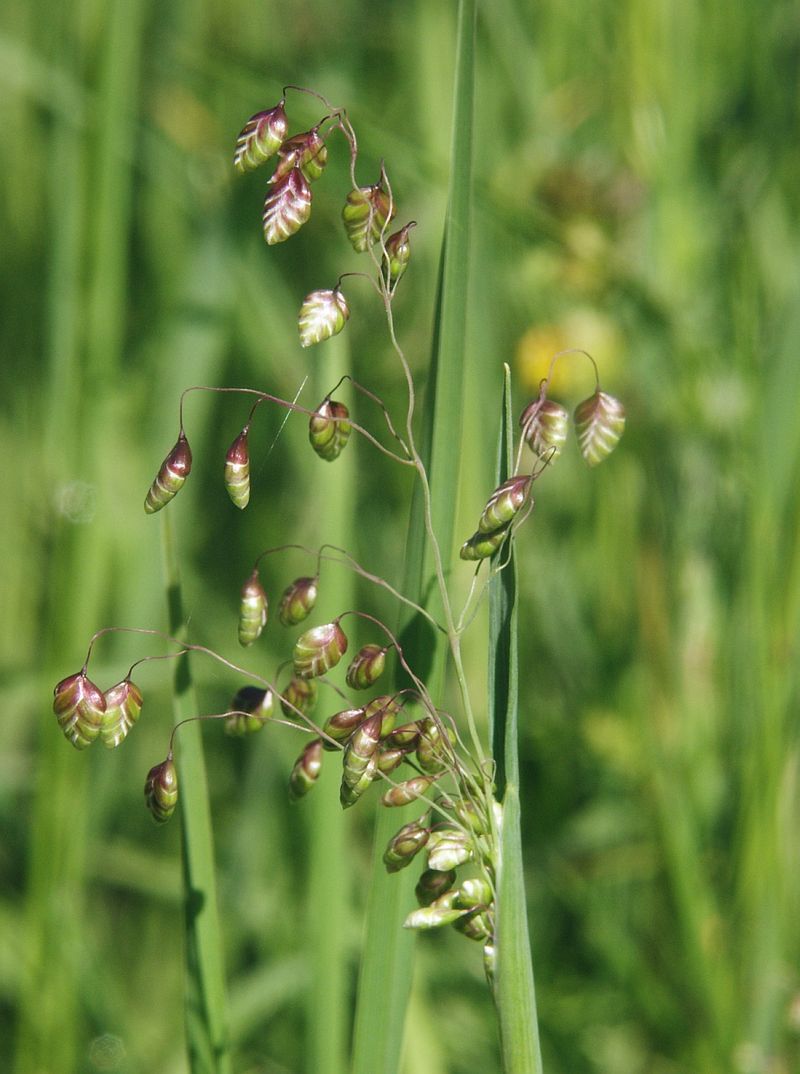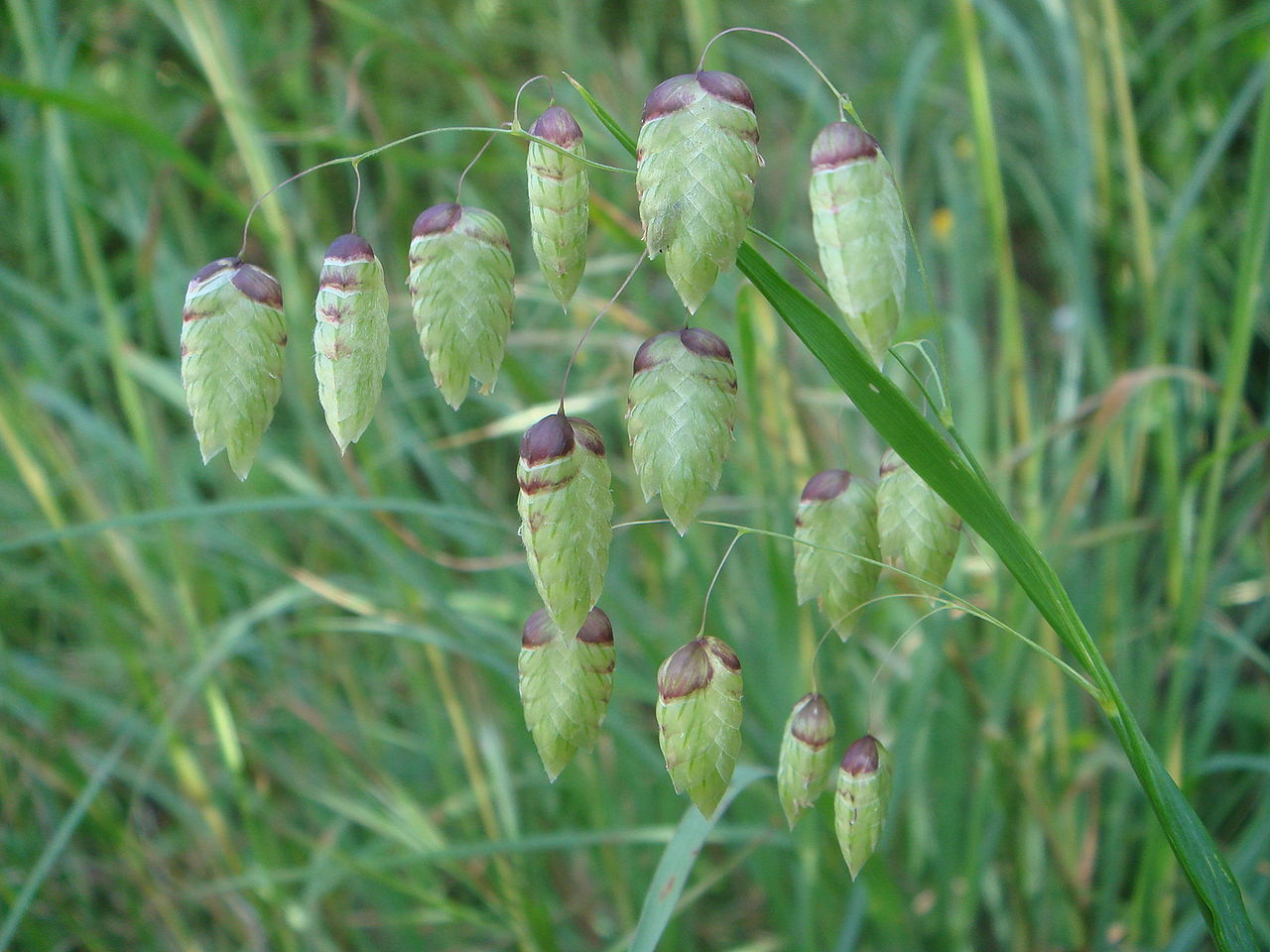An unusual looking grass with drooping panicles of oval-shaped spikelets, quaking grass is found throughout Britain but is scarce in the far north of Scotland. It grows mainly in the south on chalk downland habitats but also old meadows and pasture on either damp or dry non-acidic soils in other parts of the country. A small tufted grass with delicate panicles of flowers, quaking grass does not offer much in terms of leaves so is not over-grazed in pasture. It was first officially recorded by the botanist Mathew L’Obel in 1571.1.
It has an astonishing number of local names2. including quiver grass and tottery grass in Hampshire, silver bells in Devon, and trimmling jock in Yorkshire, where it was believed to deter mice.
Its elegant flowers make it an extremely attractive grass for the front of borders, and it would also look attractive complementing other wild flowers in containers. The way its panicles tremble in a slight breeze is attractive and gives the plant its common name. It can be grown from seed, and is included in many meadow mixes, and may also be bought as plug or pot plants.
Quaking grass Briza media
Family Poaceae – Grass family
Perennial – 15-75 cm tall spreads to 50cm
Flowering – June to August
Soils - all soils, neutral to alkaline
Sun - Full sun


Quaking grass has been chosen here for its decorative character rather than for its value to animal wildlife, but is one of many grasses associated with the mirid bug Leptopterna ferrugata and has been noted as a larval food plant for the slender brindle moth Apamea scolopacina and the delicate and pretty micro moth Coleophora lixella3. which lays its eggs on thyme where the larva feeds and over-winters, changing to grass including quaking grass in spring.4.
References
1. Pearman, D. (2017). The Discovery of the Native Flora of Britain and Ireland, A compilation of the first records for 1670 species and aggregates, covering Great Britain, Ireland, The Channel Isles and the Isle of Man. Botanical Society of Britain & Ireland. p 119
2. Vickery, R. (2019). Vickery’s Folk Flora, An A to Z of the Folklore and Uses of British and Irish Plants. Weidenfeld & Nicolson. London. p. 551
3. See the Biological Record Centre database
4. Sterling, P. and Parsons, M. 2012. Field Guide to Micro moths. British Wildlife Publishing.
Page written by Caroline Ware. Compiled by Steve Head

Greater quaking grass Briza maxima is a closely related non-native plant from North Africa which is now naturalised and spreading in southern England and Wales and a few places in Ireland.
It is easily available, especially as seed, but although rather larger than common quaking grass is an annual.
Quaking grass Briza media
Perennial – 15-75 cm tall spreads to 50cm
Flowering – June to August
Soils - all soil, neutral to alkaline
Sun - Full sun


An unusual looking grass with drooping panicles of oval-shaped spikelets, quaking grass is found throughout Britain but is scarce in the far north of Scotland. It grows mainly in the south on chalk downland habitats but also old meadows and pasture on either damp or dry non-acidic soils in other parts of the country. A small tufted grass with delicate panicles of flowers, quaking grass does not offer much in terms of leaves so is not over-grazed in pasture. It was first officially recorded by the botanist Mathew L’Obel in 1571.1.
It has an astonishing number of local names2. including quiver grass and tottery grass in Hampshire, silver bells in Devon, and trimmling jock in Yorkshire, where it was believed to deter mice.
Its elegant flowers make it an extremely attractive grass for the front of borders, and it would also look attractive complementing other wild flowers in containers. The way its panicles tremble in a slight breeze is attractive and gives the plant its common name. It can be grown from seed, and is included in many meadow mixes, and may also be bought as plug or pot plants.

Greater quaking grass Briza maxima is a closely related non-native plant from North Africa which is now naturalised and spreading in southern England and Wales and a few places in Ireland.
It is easily available, especially as seed, but although rather larger than common quaking grass is an annual.
Quaking grass has been chosen here for its decorative character rather than for its value to animal wildlife, but is one of many grasses associated with the mirid bug Leptopterna ferrugata and has been noted as a larval food plant for the slender brindle moth Apamea scolopacina and the delicate and pretty micro moth Coleophora lixella3. which lays its eggs on thyme where the larva feeds and over-winters, changing to grass including quaking grass in spring.4.
References
1. Pearman, D. (2017). The Discovery of the Native Flora of Britain and Ireland, A compilation of the first records for 1670 species and aggregates, covering Great Britain, Ireland, The Channel Isles and the Isle of Man. Botanical Society of Britain & Ireland. p 119
2. Vickery, R. (2019). Vickery’s Folk Flora, An A to Z of the Folklore and Uses of British and Irish Plants. Weidenfeld & Nicolson. London. p. 551
4. Sterling, P. and Parsons, M. 2012. Field Guide to Micro moths. British Wildlife Publishing.
Page written by Caroline Ware. Compiled by Steve Head






